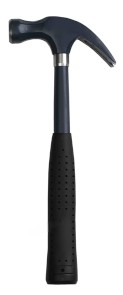Buying a hammer
Buying a hammer should really be a once in a lifetime event, because if you buy the right one, it will definitely outlast you, and probably your children. The right hammer will never break, and the only reason you should buy more than one hammer in your life is because you keep losing them. What I think is the best all-round hammer for both pros and DIY is detailed at the bottom of the page, but firstly, a little bit more information about hammer types, design, and what to look out for when buying a hammer.
Claw hammers

For me the best hammer to have in your toolbox is a curved claw hammer. Perfect design for knocking in nails as well as taking them out.
In this guide, I’m not talking about sledgehammers or club hammers, I’m mainly talking about claw hammers as they are the one type of hammer that for 98% of your DIY life is the only type of hammer you’re likely to need.
I tend to find that I probably use my hammer more for pulling things out, or breaking things down, than tapping in nails and picture hooks, so the claw design is essential in this respect, making this hammer a perfect multipurpose tool.
Hammers without a claw such as all the pein hammers and pin hammers and different shapes of mallet you find are just too specialist to be your ‘go-to’ hammer. So unless you’re a panel beater, cobbler or cabinet maker, the ideal tool for you is a claw hammer.
Common weights for claw hammers range between 16oz and 24oz. Very simply, 16oz is too light for many jobs and 24oz is too heavy. 20oz is perfect. If you’re worried about it still being too heavy, well all I can say is that a badly designed 16oz hammer will feel twice the weight, whereas the beautifully designed 20oz hammer that I’m going to recommend feels like half its weight. They look like simple tools, but trust me, its all in the weight balance and design.
Hammer handles
What a handle is made of is crucial not only for achieving a good grip, but also because this is the part that can wear and break, as well as being important for absorbing shock when you’re hammering away.
- Wood – lovely to look at, lovely in the hand, but because it has to be joined to the head, you will always have a joint and therefore a potential for problems.
- Fibreglass – the modern version of the wooden handle that is excellent on shock absorption, but again, there’s got to be a joint there somewhere, and therefore potential for weakness.
- All-steel – the head and handle is cast as one piece, with a grip bonded to the shaft. My choice every time as there’s no joint between head and shaft, so there is no potential point of weakness. You can get leather grips, but I prefer the vinyl because of the way it is bonded during manufacture – it’s just never gonna come off!
My hammer choice
If there’s one tool where we all have the ability to buy the ‘Rolls-Royce’ of that tool, without breaking the bank, it’s with a hammer. Yes, it is more expensive than the standard. Yes, it is only a hammer. But, if it is possible to get excited about, or achieve a sense of job satisfaction out of using a hammer, then an Estwing hammer is the one that will provide this! Estwings are beautifully ‘balanced’, well made, and hardwearing to the point of being indestructible, making them not only my favourite hammer, but the favourite of most pros across the globe.
For the best prices on Estwings, be sure to check out Amazon. As mentioned earlier, 20oz is what I consider to be the perfect weight, but you can go heavier or lighter should you wish. For some price comparison, you may also want to take a look at Screwfix, Tooled-up and The UK Tool Centre.
